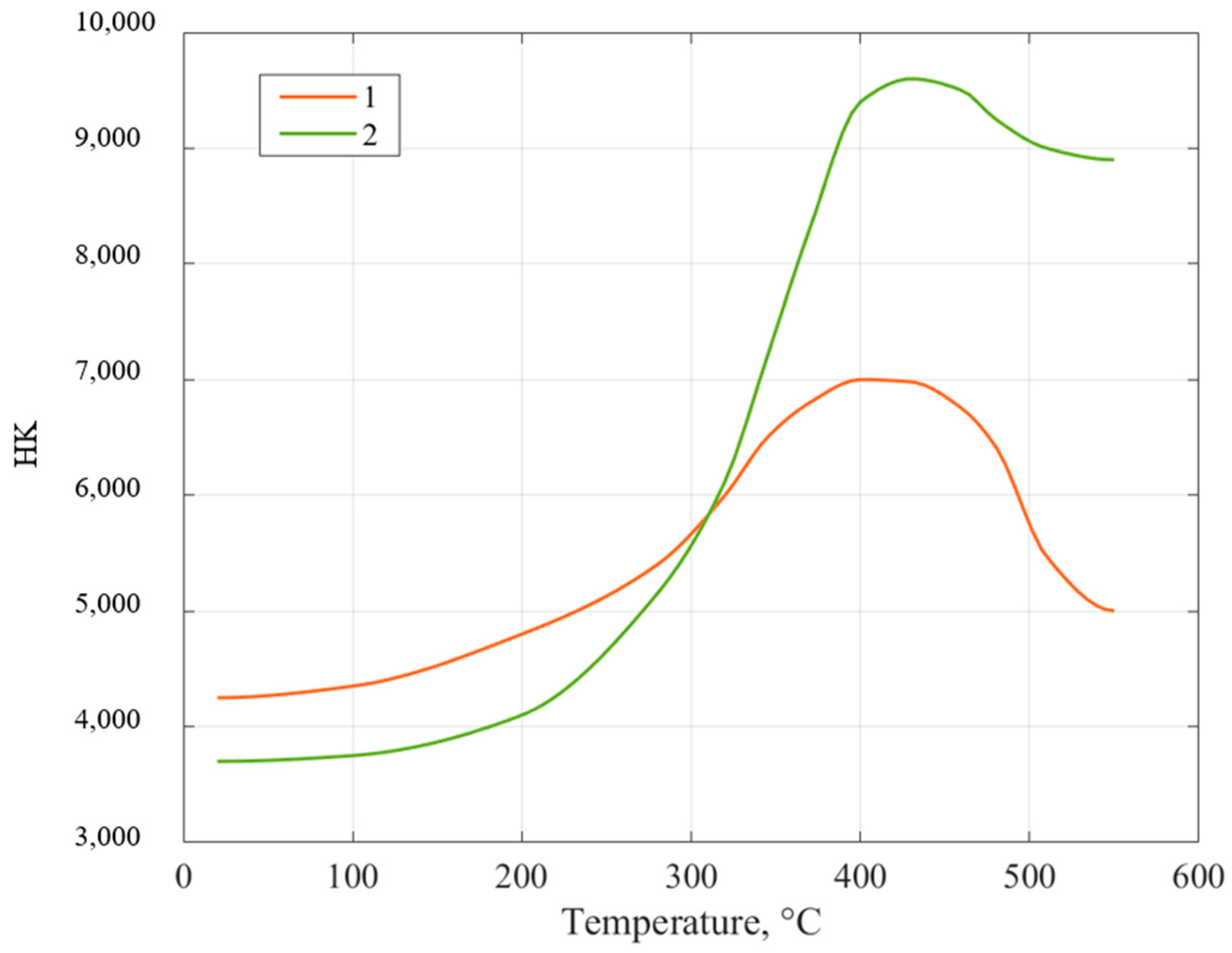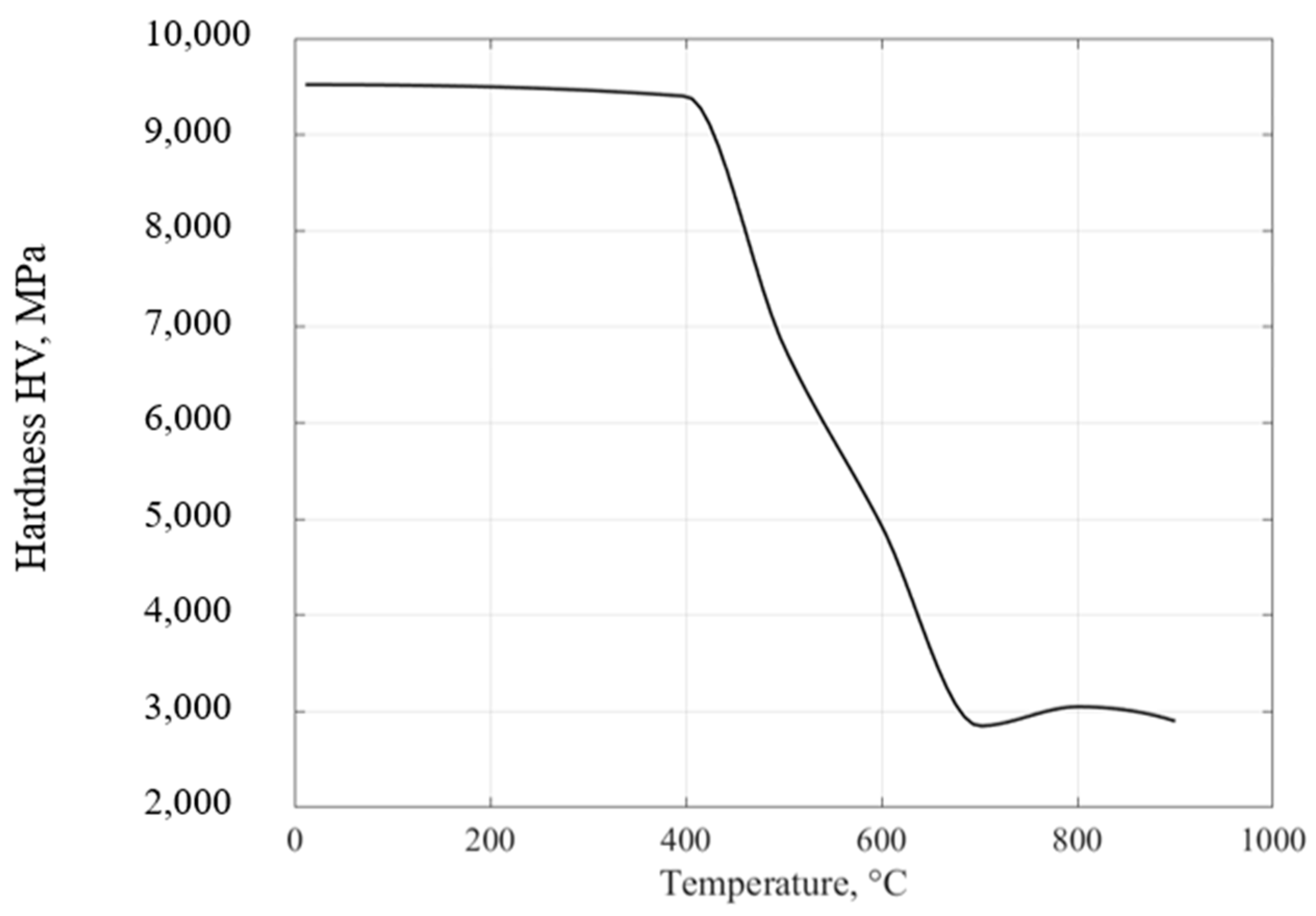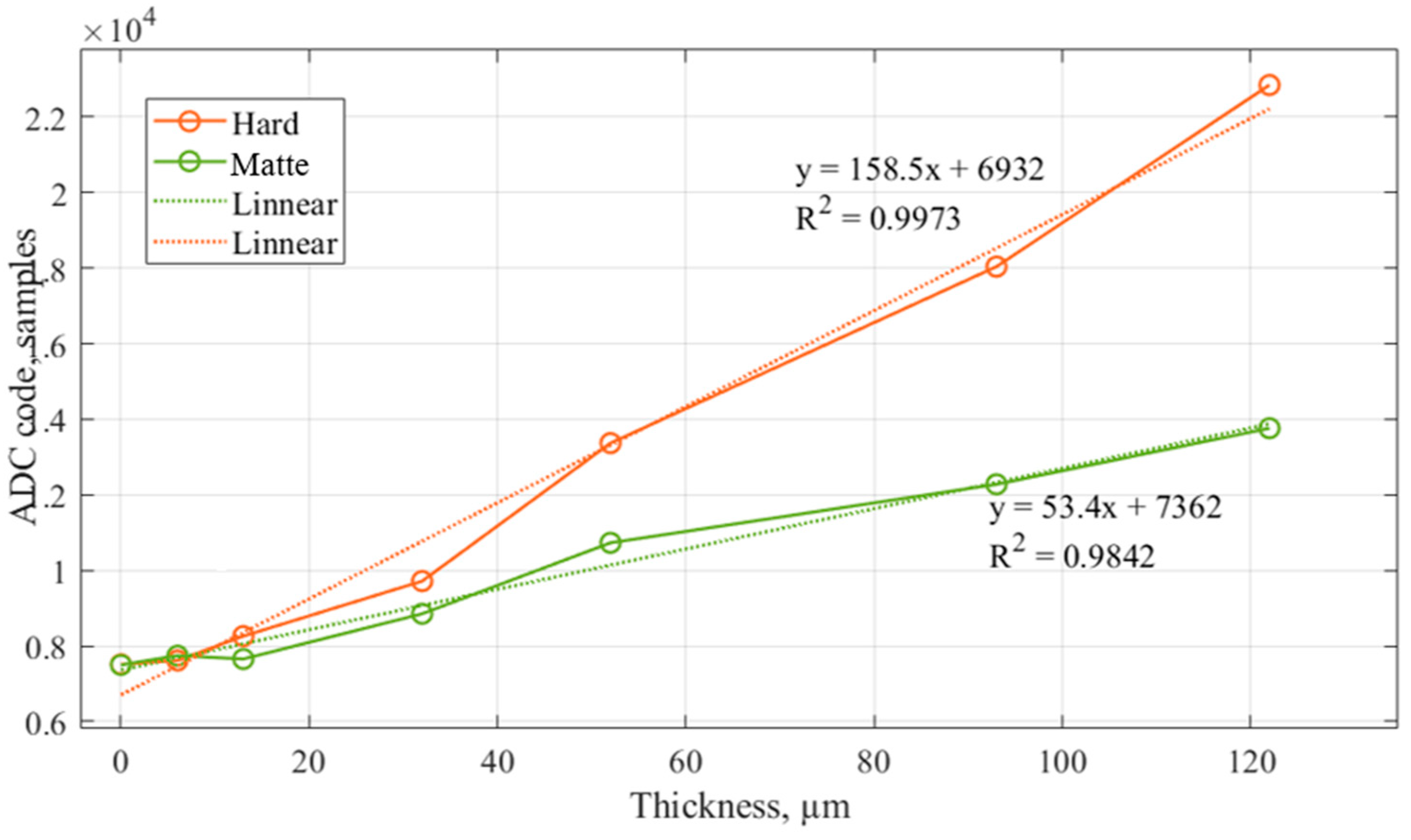Multi-Parameter Complex Control of Metal Coatings on Ball Plugs of Pipeline Shut-Off Valves
Abstract
1. Introduction
2. Materials and Methods
2.1. Samples
2.2. Standard Methods for Testing of Coatings
2.2.1. Thickness Control of Coatings
2.2.2. Control of Mechanical Parameters (Hardness)
2.3. Equipment
3. Results
3.1. ENP Coatings
3.1.1. Measurement of Coating Thicknesses
3.1.2. Hardness Testing
3.2. Chrome Coatings
3.2.1. Measurement of Coating Thicknesses
3.2.2. Hardness Testing
4. Discussion
4.1. ENP Coatings
4.2. Chrome Coatings
5. Conclusions
- The performed studies confirmed the necessity of operational and output complex multi-parameter control of metal coatings of shut-off valve ball plugs by unified methods to ensure the uniformity and required accuracy of measurements.
- The thickness measurement of ENP coatings should be performed by the magnetic induction method before the heat treatment operation.
- Taking into account the range of standardized coating thicknesses, hardness testing (hardness measurement) may be performed by the UCI method with a load not exceeding 10 N.
- For adjustment and calibration of the equipment before measurement, it is necessary to use ball plugs certified by direct measurement methods, with coatings manufactured in accordance with the technologies and materials used at the enterprises.
- During the incoming inspection, it is necessary to use similar instruments, control samples, and measurement methods. It should also be taken into account that the incoming inspection of ENP coating thickness by electromagnetic methods does not provide the required accuracy.
Author Contributions
Funding
Data Availability Statement
Acknowledgments
Conflicts of Interest
References
- Gogolinskii, K.V.; Alekhnovich, V.V.; Ivkin, A.E.; Umanskii, A.S.; Solomenchuk, P.V. Study of methods of incoming inspection of metal coatings of shut-off valves of pipelines. Kontrol’. Diagn. 2023, 4, 38–47. [Google Scholar] [CrossRef]
- Lyubchik, A.N.; Krapivskii, E.I.; Bolshunova, O.M. Prediction of the Technical Status of Pipeline Based on Analysis. J. Min. Inst. 2011, 192, 153–156. [Google Scholar]
- Shammazov, I.; Dzhemilev, E.; Sidorkin, D. Improving the Method of Replacing the Defective Sections of Main Oil and Gas Pipelines Using Laser Scanning Data. Appl. Sci. 2022, 13, 48. [Google Scholar] [CrossRef]
- Yamilev, M.Z.; Pshenin, V.V.; Matveev, D.S.; Podlesniy, D.S.; Bezimyannikov, T.I. The Use of Compact Inspection Devices for Monitoring the Technical Condition of Pipelines in Protective Cases. Neft. Khozyaystvo Oil Ind. 2022, 2, 106–110. [Google Scholar] [CrossRef]
- Krizsky, V.N.; Kosarev, O.V.; Alexandrov, P.N.; Luntovskaya, Y.A. Mathematical Modeling of the Electric Field of an In-Line Diagnostic Probe of a Cathode-Polarized Pipeline. J. Min. Inst. 2024, 265, 156–164. [Google Scholar]
- Dzhemilev, E.R.; Shammazov, I.A.; Sidorkin, D.I.; Mastobaev, B.N.; Gumerov, A.K. Developing Technology and Device for the Main Pipelines Repair with Cutting out Their Defective Sections. Neft. khozyaystvo Oil Ind. 2022, 10, 78–82. [Google Scholar] [CrossRef]
- Vasin, S.A.; Plakhotnikova, E.V. Electric Drive Setting Torque Calculation Method in Electric Drive Shut-off Valve System with Rectilinea Displacement of the Valve Closure. J. Min. Inst. 2018, 232, 407–412. [Google Scholar] [CrossRef]
- Dong, V.H. Ball Valves for Gas Pipelines. In Proceedings of the New Technologies for the Oil and Gas Region: Materials of the All-Russian Scientific and Practical Conference of Students, Graduate Students and Young Scientists, Dedicated to the 50th Anniversary of TII-TyumGNGU, Tyumen, Russia, 1 January 2013; pp. 357–359. [Google Scholar]
- Gorlanov, E.S.; Leontev, L.I. Directions in the Technological Development of Aluminium Pots. J. Min. Inst. 2024, 266, 246–259. [Google Scholar]
- Piksaykin, R.V.; Stepanenko, O.A. Control of Gas and Liquid Leakage in Ball Valves of Main Pipelines. Weld. Diagn. 2012, 3, 51–52. [Google Scholar]
- Kovalskaya, K.V.; Gorlanov, E.S. Al–Ti–B Master Alloys: Structure Formation in Modified Alloys. Tsvetnye Met. 2022, 7, 57–64. [Google Scholar] [CrossRef]
- API 6D:2008; Specification for Pipeline Valves. American Petroleum Institute: Washinton, DC, USA, 2008.
- ISO 14313:2007; Petroleum and Natural Gas Industries. Pipeline Transportation Systems. Pipeline Valves. International Standard Organization: Geneva, Switzerland, 2007.
- ASME B16.34-2013; Valves—Flanged, Threaded, and Welding End. The American Society of Mechanical Engineers: New York, NY, USA, 2013.
- MSS SP-55; Quality Standard for Steel Casting for Valves, Flanges, Fittings and Other Piping Components. Manufacturers Standardization Society: Alexandria, VA, USA, 2001.
- MU.10.36; Irkutsk Oil Company OOO “Unified Technical Requirements for the Supply of Ball Valves”. Irkutsk Oil Company: Irkutsk, Russia, 2019.
- STO Gazprom 2-4.1-1108-2017; Pipeline Fittings. Special Ball Valves. General Technical Conditions. PJSC Gazprom: Moscow, Russia, 2017.
- Singh, D.D.N.; Ghosh, R. Electroless Nickel–Phosphorus Coatings to Protect Steel Reinforcement Bars from Chloride Induced Corrosion. Surf. Coat. Technol. 2006, 201, 90–101. [Google Scholar] [CrossRef]
- Elsener, B.; Crobu, M.; Scorciapino, M.A.; Rossi, A. Electroless Deposited Ni–P Alloys: Corrosion Resistance Mechanism. J. Appl. Electrochem. 2008, 38, 1053–1060. [Google Scholar] [CrossRef]
- ACUÑA, J.C.; Echeverría, F.E. A review with respect to electroless ni-p (enp) coatings: Fundamentals and properties. Part I. J. Basic Appl. Res. Int. 2015, 10, 79–85. [Google Scholar]
- Popov, G.; Bolobov, V.; Zhuikov, I.; Zlotin, V. Development of the Kinetic Equation of the Groove Corrosion Process for Predicting the Residual Life of Oil-Field Pipelines. Energies 2023, 16, 7067. [Google Scholar] [CrossRef]
- Hamburg, Y.D. Chemical Nickel Plating (Production of Nickel-Phosphorus Coatings by Electrocatalytic Reduction with Hypophosphite); RAS: Moscow, Russai, 2020. [Google Scholar]
- Martinuzzi, S.M.; Donati, L.; Giurlani, W.; Pizzetti, F.; Galvanetto, E.; Calisi, N.; Innocenti, M.; Caporali, S. A Comparative Research on Corrosion Behavior of Electroplated and Magnetron Sputtered Chromium Coatings. Coatings 2022, 12, 257. [Google Scholar] [CrossRef]
- Wang, L.; Liao, Q.; Gan, S. Corrosion Behavior of Chromium Coating on Ferritic/Martensitic Steels in High Temperature Lbe. SSRN 2022, 7, 1–23. [Google Scholar] [CrossRef]
- Kovensky, I.M. Metal Coatings of Parts and Structures of Oil and Gas Equipment. In Heat Treatment: Textbook; TyumGNGU: Tyumen, Russia, 2014; ISBN 978-5-9961-0829-9. [Google Scholar]
- Khozyaev, I.A. Fundamentals of Food Engineering Technologies: Textbook; Lan: St. Petersburg, Russia, 2022; ISBN 978-5-8114-3597-5. [Google Scholar]
- Solodkova, L.N.; Kudryavtsev, V.N. Electrolytic Chrome Plating; Globus: Moscow, Russia, 2007. [Google Scholar]
- Salakhova, R.K.; Tikhoobrazov, A.B. Thermal resistance of electrolytic chromium coatings. Aviat. Mater. Technol. 2019, 55, 60–67. [Google Scholar] [CrossRef]
- Pletnev, D.V.; Brusentsova, V.N. Basics of Wear-Resistant Chrome Plating Technology; Mashgiz: Moscow, Russia, 1953. [Google Scholar]
- Shluger, M.A. Acceleration and Improvement of Chrome Plating of Machine Parts; Mashgiz: Moscow, Russia, 1961. [Google Scholar]
- Potapov, A.I.; Syasko, V.A. Non-Destructive Methods and Means of Monitoring the Thickness of Coatings and Products. In Scientific, Methodological, Reference Manual; Humanistics: St. Petersburg, Russia, 2009; p. 904. [Google Scholar]
- Kostin, V.N.; Smorodinsky, Y.G. Multi-Purpose Hardware-Software Systems for Active Electromagnetic Control as a Trend. Defectoscopy 2017, 7, 23–34. [Google Scholar]
- Gromyka, D.S.; Gogolinskiy, K.V. Introduction of Evaluation Procedure of Excavator Bucket Teeth into Maintenance and Repair: Promptse. MIAB. Min. Inf. Anal. Bull. 2023, 8, 94–111. [Google Scholar] [CrossRef]
- Salmi, M.; Magrini, A.; Gigante, G.E.; Barra, O.A. Coating Thickness Measurement by Means of the Radioisotope X-ray Fluorescence Technique. Isot. Isot. Environ. Health Stud. 1978, 14, 380–381. [Google Scholar] [CrossRef]
- Mashin, N.I.; Leontyeva, A.A.; Tumanova, A.N.; Ershov, A.A. X-ray Fluorescence Method for Determining the Thickness of Aluminum Coating on Steel. J. Appl. Spectrosc. 2011, 78, 454–459. [Google Scholar] [CrossRef]
- Gogolinsky, K.V.; Ivkin, A.E.; Alekhnovich, V.V.; Vasiliev, A.Y.; Tyurnina, A.E.; Vasiliev, A.S. Evaluation of the Accuracy Indicators in Determination of the Coating Thickness by Crater Grinding Method. Ind. Lab. Diagn. Mater. 2020, 86, 39–44. [Google Scholar] [CrossRef]
- Syasko, V.A.; Vasilev, A.Y. Pulse magnetic thickness inspection of metallic coatings. Defectoscopy 2021, 9, 63–70. [Google Scholar] [CrossRef]
- ISO 21968:2019; Non-Magnetic Metallic Coatings on Metallic and Non-Metallic Basis Materials—Measurement of Coating Thickness—Phase-Sensitive Eddy-Current Method. International Standard Organization: Geneva, Switzerland, 2019.
- Chernyshev, A.V.; Zagorskiy, I.E.; Sharando, V.I. Multi-Frequency Method of Control for Eddy Current Thickness Measurement. Proc. Natl. Acad. Sci. Belarus Phys. Ser. 2019, 64, 118–126. [Google Scholar] [CrossRef]
- Chernyshev, A.V.; Zagorskiy, I.E.; Sharando, V.I. Control the Thickness of the Chrome Coating Using Eddy Currents Method. Non-Destr. Test. Control 2021, 64, 38–42. [Google Scholar]
- Shakhnazarov, K.Y.; Vologzhanina, S.A.; Khuznakhmetov, R.M. A Relationship between Abnormal Electrical Properties in Non-Ferrous Alloys and Phase Equilibrium Diagrams. Tsvetnye Met. 2024, 2, 53–59. [Google Scholar] [CrossRef]
- Gogolinskii, K.V.; Syasko, V.A.; Umanskii, A.S.; Nikazov, A.A.; Bobkova, T.I. Mechanical Properties Measurements with Portable Hardness Testers: Advantages, Limitations, Prospects. J. Phys. Conf. Ser. 2019, 1384, 012012. [Google Scholar] [CrossRef]
- Useinov, A.; Gogolinsky, K. Mechanical Properties of Ultrathin Carbon Diamond-like Coatings. Nanoindustry 2010, 5, 54–57. [Google Scholar]
- ISO 6507-1:2023; Metallic Materials—Vickers Hardness Test. Part 1: Test Method. International Standard Organization: Geneva, Switzerland, 2023.
- ASTM A1038-19; Standard Test Method for Portable Hardness Testing by the Ultrasonic Contact Impedance Method. ASTM: West Conshohocken, PA, USA, 2019.
- Ashirova, A.D.; Gogolinsky, K.V.; Nikazov, A.A. Possibilities of Using Portable Hardness Testers for Non-Destructive Testing of the Mechanical Properties of Coatings. In Proceedings of the XXII All-Russian Conference on Non-Destructive Testing and Technical Diagnostics, Moscow, Russia, 3–5 March 2020; Publishing House “Spectrum”: Moscow, Russia, 2020; pp. 181–184. [Google Scholar]







| Name | Diameter, mm | Base Metal | Coating | Coating Thickness, μm | Coating Hardness, HV |
|---|---|---|---|---|---|
| AD-136 2” | 84 | LF2 1 | ENP | 76 ± 3 | 910 |
| AD-136 4” | 170 | LF2 | ENP | 76 ± 3 | 910 |
| Name | Type of Chrome | Base Metal | Coating | Coating Thickness, μm | Coating Hardness, HV |
|---|---|---|---|---|---|
| 5–1 | Hard | C20E2C | Chrome | 5 ± 1 | 700 |
| 10–1 | Hard | C20E2C | Chrome | 10 ± 3 | 700 |
| 35–1 | Hard | C20E2C | Chrome | 35 ± 4 | 700 |
| 50–1 | Hard | C20E2C | Chrome | 50 ± 5 | 800 |
| 90–1 | Hard | C20E2C | Chrome | 90 ± 6 | 800 |
| 110–1 | Hard | C20E2C | Chrome | 110 ± 10 | 900 |
| 5–2 | Matte | C20E2C | Chrome | 5 ± 1 | 350 |
| 10–2 | Matte | C20E2C | Chrome | 10 ± 3 | 350 |
| 20–2 | Matte | C20E2C | Chrome | 20 ± 4 | 350 |
| 40–2 | Matte | C20E2C | Chrome | 40 ± 5 | 370 |
| 70–2 | Matte | C20E2C | Chrome | 70 ± 6 | 370 |
| 110–2 | Matte | C20E2C | Chrome | 110 ± 10 | 380 |
| No. | Measured Parameter/Method of Measurement | Equipment | Metrological Characteristic | Value |
|---|---|---|---|---|
| 1 | Coating thickness/Crater grinding method | CAT2c 1 ball abrasion machine, Walter UHL VMM 150 2 Measuring Microscope | Accuracy parameter (error limits for p = 0.95), ±δ | 6.0% |
| 2 | Coating thickness/ Magnetoinduction method | K6-C Multifunctional Coating Thickness Gauge with F1 3 probe | Limit of acceptable basic absolute error of coating thickness measurements at ambient air temperature (20 ± 5) °C, mm | ±(0.01 h + 0.001) |
| 3 | Coating thickness/ Eddy current phase method | K6-C Multifunctional Coating Thickness Gauge with PH1 3 probe | Limit of acceptable basic absolute error of coating thickness measurements at ambient air temperature (20 ± 5) °C, mm | ±(0.02 h + 0.001) |
| 4 | Hardness HV/ Static method (Vickers microhardness) | Shimadzu HMV-G30S Micro Hardness Tester | Limit of acceptable error of loads in the main/additional ranges, not more than | ±2% |
| 5 | Hardness HV/ Ultrasonic contact impedance method | KT-C Hardness Tester with U-10N 4 probe | Limit of acceptable absolute error of hardness measurement, units of measurement | ±20 HV |
| Name | Declared | Crater Grinding Method | Magnetoinduction Method | Eddy Current Phase Method |
|---|---|---|---|---|
| AD-136 2” | 76 ± 4 | 153.0 ± 1.3 | 36 ± 1 | 147 ± 3 |
| AD-136 4” | 76 ± 4 | 70.0 ± 1.1 | 70 ± 2 | 45 ± 1 |
| Name | Declared | Static Method | Ultrasonic Contact Impedance Method | |
|---|---|---|---|---|
| Load 0.1 kgf | Load 0.5 kgf | |||
| AD-136 2” | 910 ± 20 | 908 ± 18 | 751 ± 18 | 740 ± 20 |
| AD-136 4” | 910 ± 20 | 441 ± 18 | 520 ± 18 | 780 ± 20 |
| Name | Coating Thickness, μm | Code Value for Thickness Measurement, Units | ||
|---|---|---|---|---|
| Declared | Crater Grinding Method | Magnetic Induction Method | Eddy Current Phase Method | |
| 5–1 | 5 ± 1 | 6.0 ± 1.1 | 6 ± 1 | 7436 ± 56 |
| 10–1 | 10 ± 3 | 12.0 ± 1.6 | 13 ± 1 | 7655 ± 63 |
| 35–1 | 35 ± 4 | 34.0 ± 3.1 | 32 ± 1 | 8852 ± 95 |
| 50–1 | 50 ± 5 | 51.0 ± 2.9 | 52 ± 2 | 10,730 ± 116 |
| 90–1 | 90 ± 6 | 95.0 ± 3.9 | 93 ± 2 | 12,278 ± 120 |
| 110–1 | 110 ± 10 | 118.0 ± 12.9 | 122 ± 3 | 13,762 ± 128 |
| 5–2 | 5 ± 1 | 1.8 ± 1.3 | 2 ± 1 | 7615 ± 33 |
| 10-2 | 10 ± 3 | 8.0 ± 1.3 | 7 ± 1 | 8261 ± 23 |
| 20–2 | 20 ± 4 | 17.0 ± 2.0 | 19 ± 1 | 9717 ± 32 |
| 40–2 | 40 ± 5 | 45.0 ± 4.1 | 45 ± 2 | 13,369 ± 53 |
| 70–2 | 70 ± 6 | 75.2 ± 3.0 | 80 ± 4 | 18,039 ± 248 |
| 110–2 | 110 ± 10 | 101.1 ± 6.1 | 111 ± 3 | 22,846 ± 406 |
| Name | Coating Thickness, Crater Grinding Method, μm | Static Method, HV | Ultrasonic Contact Impedance Method | |
|---|---|---|---|---|
| Hardness, HV | Load, kgf | |||
| 35–1 | 34.0 ± 3.1 | 632 ± 167 | 0.05 | 717 ± 4 |
| 50–1 | 51.0 ± 2.9 | 1028 ± 192 | 0.1 | 779 ± 10 |
| 90–1 | 95.0 ± 3.9 | 821 ± 119 | 0.2 | 844 ± 9 |
| 110–1 | 118.0 ± 12.9 | 972 ± 99 | 0.2 | 754 ± 8 |
| 40–2 | 45.0 ± 4.1 | 377 ± 35 | 0.1 | 358 ± 10 |
| 70–2 | 75.2 ± 3.0 | 371 ± 29 | 0.2 | 363 ± 9 |
| 110–2 | 101.1 ± 6.1 | 382 ± 11 | 0.2 | 318 ± 5 |
Disclaimer/Publisher’s Note: The statements, opinions and data contained in all publications are solely those of the individual author(s) and contributor(s) and not of MDPI and/or the editor(s). MDPI and/or the editor(s) disclaim responsibility for any injury to people or property resulting from any ideas, methods, instructions or products referred to in the content. |
© 2024 by the authors. Licensee MDPI, Basel, Switzerland. This article is an open access article distributed under the terms and conditions of the Creative Commons Attribution (CC BY) license (https://creativecommons.org/licenses/by/4.0/).
Share and Cite
Alekhnovich, V.; Syasko, V.; Umanskii, A. Multi-Parameter Complex Control of Metal Coatings on Ball Plugs of Pipeline Shut-Off Valves. Inventions 2024, 9, 78. https://doi.org/10.3390/inventions9040078
Alekhnovich V, Syasko V, Umanskii A. Multi-Parameter Complex Control of Metal Coatings on Ball Plugs of Pipeline Shut-Off Valves. Inventions. 2024; 9(4):78. https://doi.org/10.3390/inventions9040078
Chicago/Turabian StyleAlekhnovich, Varvara, Vladimir Syasko, and Alexander Umanskii. 2024. "Multi-Parameter Complex Control of Metal Coatings on Ball Plugs of Pipeline Shut-Off Valves" Inventions 9, no. 4: 78. https://doi.org/10.3390/inventions9040078
APA StyleAlekhnovich, V., Syasko, V., & Umanskii, A. (2024). Multi-Parameter Complex Control of Metal Coatings on Ball Plugs of Pipeline Shut-Off Valves. Inventions, 9(4), 78. https://doi.org/10.3390/inventions9040078






